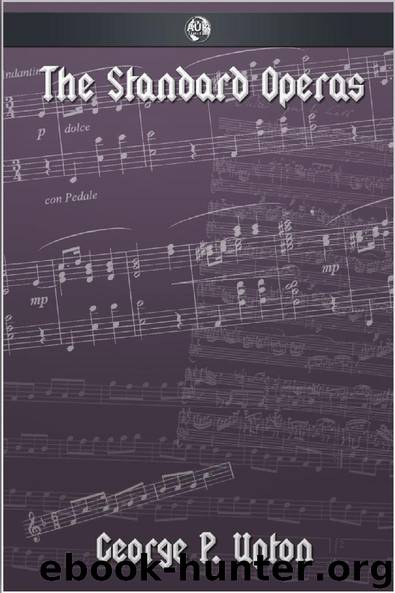The Standard Operas by George P. Upton

Author:George P. Upton
Language: eng
Format: epub
Tags: reference, opera, history, beethoven, bizet, humperdinck, mozart, verdi, wagner
ISBN: 9781781667590
Publisher: Andrews UK Limited 2012
Published: 2012-06-19T00:00:00+00:00
ROSSINI.
Gioachini Antonio Rossini was born at Pesaro, Italy, Feb. 29, 1792. His early lessons in music were taken with Tesei, and as a lad he also appeared upon the stage as a singer. In 1807 he was admitted to the class of Padre Mattei at the Bologna Conservatory, where he took a prize for a cantata at the end of his first year. At the beginning of his career in Italy he was commissioned to write an opera for Venice. It was "La Cambiale di Matrimonio," an opera buffa in one act, and was produced in 1810. During the next three years he wrote several works for Venice and Milan, which were successful, but none of them created such a furor as "Tancredi." This was followed by "L' Italiana in Algeri," "Aureliano in Palmira," and "Il Turco in Italia." In 1815 appeared "The Barber of Seville." Strange as it may seem, it was at first condemned, not on its merits, but because the composer had trenched, as it was supposed, upon the ground already occupied by the favorite Paisiello, though he applied to the latter before writing it, and received his assurances that he had no objection to his use of the same subject. "Otello" followed the "Barber" at Naples in 1816, and "Cenerentola" in 1817, and both were extraordinarily successful. The "Gazza Ladra" was produced at Milan in 1817, and was followed by "Armida" at Naples in the same year. His next great work was the oratorio, "Moses in Egypt," which is also given as opera. The "Donna del Lago," based upon Walter Scott's "Lady of the Lake," was produced at Naples in 1819. The same year he opened the Carnival in Milan with "Bianca e Faliero," and before its close he produced "Maometto secondo" at Naples. During the next two or three years his muse was very prolific, and in 1823 appeared another of his great works, "Semiramide," which made a furor at Venice. That year he went to London and gave concerts, in which he sang, and thence to Paris, which now became his home. His greatest work for Paris was "William Tell," which was produced in 1829, and it was also his last, though by an arrangement with the Government of Charles X. it was to be the first of a series of five. The revolution of 1830 destroyed his plans. In 1836 he heard Meyerbeer's "Huguenots," and resolved to write no more. Four years before this he had written the "Stabat Mater," but it was not produced complete until 1842. From this time on he lived at his villa at Passy the life of a voluptuary and died there Nov. 13, 1868. The catalogue of his works is immense, including fifty operas alone, of which in a necessarily brief sketch it has been possible to mention only those best known.
THE BARBER OF SEVILLE.
"Il Barbiere di Siviglia," an opera buffa in two acts, words by
Sterbini, founded on Beaumarchais's comedy, was first produced at the
Argentina Theatre, Rome, Feb.
Download
This site does not store any files on its server. We only index and link to content provided by other sites. Please contact the content providers to delete copyright contents if any and email us, we'll remove relevant links or contents immediately.
Reforming Music by Chiara Bertoglio(655)
Drums For Dummies by Jeff Strong(547)
You Are the Music: How Music Reveals What it Means to be Human by Williamson Victoria(538)
Bound by a Child(495)
Hal Leonard Guitar Method--Guitar Setup & Maintenance by Chad Johnson(470)
Harmonica Aerobics by David Harp(470)
Note by Note by Tricia Tunstall(420)
Slash - Signature Licks - A Step-by-Step Breakdown of His Guitar Styles & Techniques by Troy Nelson(401)
First Steps by Sean Michael(392)
Your First Fake Book by Hal Leonard Corporation(389)
The Audio Expert by Winer Ethan;(388)
Enchanted Journeys - The Essential Guide for the Native American Style Flute by Todd Chaplin(385)
First Step by Sean Michael(381)
Celtic Harp Solos by Kim Robertson(378)
Suzuki: 21 Pieces for Violin With Guitar by Thomas Heck(360)
Breeze Easy Flute, Book 1 (Breeze-Easy Series) by Valentine Anzalone(360)
The Artist as Citizen by Polisi Joseph W(349)
Music Festivals by Tamsin King(348)
Hal Leonard Classical Guitar Method (Tab Edition) by Paul Henry(340)
